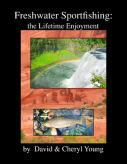Aquatic Environment
The aquatic environments components relate to the fish are aquatic plants, temperature, light, oxygen, pH, and the surface film. Each will be discussed so that the angler has a better understanding of the factors that influence a fishes’ behavior.
Aquatic Plants
The presence of aquatic plants is one of the best indicators of whether a lake or a stream will be a good producer of fish. Most aquatic life which fish feed upon requires these plants for food.
Light
Light influences fish’s activities. A photo period is defined as the amount of day light in a twenty four hour period.
Oxygen
Oxygen is essential to all aquatic animal life. Because the distribution of oxygen throughout a body of water without it respiration is impossible.
pH
The pH scale is a measure of the acid and base concentration of a solution. A pH of 7 is the neutral pH; furthermore, 0-7 is the acid range and 7-14 is the base or alkalinity range.
Surface Film
The surface film tension is the property of a liquid by which it acts as if its surface is a stretched elastic membrane. This tension allows insects to stand on the water’s surface.
Temperature
The purpose of this segment is to provide background information concerning the relationship between water temperature and fish. Since fish inhabit only a small fraction of a body of water, it is imperative to be able to locate these areas; otherwise, it is a waste of your time to fish in areas void of fish.
Background Data
Fish are cold blooded animals with their body temperatures controlled by their environments. Temperature directly affects their activities, and each fish species has an ideal temperature range in which they are the most active.

© 2026 The Gale Group, Inc. All rights reserved.
© 2026 Perigee Learning LLC. All rights reserved.
LoveTheOutdoors.com is owned and operated by Advameg, Inc. © 2026 Advameg, Inc.
Camping Adventures • Dutch Oven Cooking • Sports Knots
Fly Tying • Freshwater Fishing • Fly Fishing

